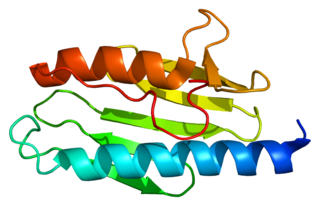
Friedreich's ataxia is an autosomal-recessive genetic disease that causes difficulty walking, a loss of coordination in the arms and legs, and impaired speech that worsens over time. Symptoms generally start between 5 and 20 years of age. Many develop hypertrophic cardiomyopathy and require a mobility aid such as a cane, walker, or wheelchair in their teens. As the disease progresses, some affected people lose their sight and hearing. Other complications may include scoliosis and diabetes mellitus.

Idebenone is a drug that was initially developed by Takeda Pharmaceutical Company for the treatment of Alzheimer's disease and other cognitive defects. This has been met with limited success. The Swiss company Santhera Pharmaceuticals has started to investigate it for the treatment of neuromuscular diseases. In 2010, early clinical trials for the treatment of Friedreich's ataxia and Duchenne muscular dystrophy have been completed. As of December 2013 the drug is not approved for these indications in North America or Europe. It is approved by the European Medicines Agency (EMA) for use in Leber's hereditary optic neuropathy (LHON) and was designated an orphan drug in 2007.
Ustekinumab, sold under the brand name Stelara among others, is a monoclonal antibody medication developed by Janssen Pharmaceuticals, for the treatment of Crohn's disease, ulcerative colitis, plaque psoriasis and psoriatic arthritis, targeting both IL-12 and IL-23.

Maribavir, sold under the brand name Livtencity, is an antiviral medication that is used to treat post-transplant cytomegalovirus (CMV). Maribavir is a cytomegalovirus pUL97 kinase inhibitor that works by preventing the activity of human cytomegalovirus enzyme pUL97, thus blocking virus replication.

Bardoxolone methyl is an experimental and orally-bioavailable semi-synthetic triterpenoid, based on the scaffold of the natural product oleanolic acid. Pre-clinical studies indicate that the compound acts as an activator of the Nrf2 pathway and an inhibitor of the NF-κB pathway. A phase 3 clinical trial evaluating bardoxolone methyl for the treatment of chronic kidney disease (CKD) was terminated in October 2012 after patients treated with the drug were found to have experienced a higher rate of heart-related adverse events, including heart failure, hospitalizations, and deaths.
Reata Pharmaceuticals, Inc. is a pharmaceutical company based in Plano, Texas. Founded in 2002, it is primarily focused on investigating experimental oral antioxidative and anti-inflammatory drugs, which dually activate the antioxidative transcription factor Nrf2 and inhibit the pro-inflammatory transcription factor NF-κB.
Abaloparatide, sold under the brand name Tymlos among others, is a parathyroid hormone-related protein (PTHrP) analog medication used to treat osteoporosis. It is an anabolic agent.
Anifrolumab, sold under the brand name Saphnelo, is a monoclonal antibody used for the treatment of systemic lupus erythematosus. It binds to the type I interferon receptor, blocking the activity of type I interferons such as interferon-α and interferon-β.
Evinacumab, sold under the brand name Evkeeza, is a monoclonal antibody medication for the treatment of homozygous familial hypercholesterolemia (HoFH).
Inebilizumab, sold under the brand name Uplizna, is a medication for the treatment of neuromyelitis optica spectrum disorder (NMOSD) in adults. Inebilizumab is a humanized mAb that binds to and depletes CD19+ B cells including plasmablasts and plasma cells.
Mirikizumab, sold under the brand name Omvoh, is a monoclonal antibody used for the treatment of ulcerative colitis. It is designed to attach to interleukin-23 (IL-23) and block its activity.
Di-deuterated ethyl linoleate is an experimental, orally-bioavailable synthetic deuterated polyunsaturated fatty acid (PUFA), a part of reinforced lipids. It is an isotopologue of linoleic acid, an essential omega-6 PUFA. The deuterated compound, while identical to natural linoleic acid except for the presence of deuterium, is resistant to lipid peroxidation which makes studies of its cell-protective properties worthwhile.
Sutimlimab, sold under the brand name Enjaymo, is a monoclonal antibody that is used to treat adults with cold agglutinin disease (CAD). It is given by intravenous infusion. Sutimlimab prevents complement-enhanced activation of autoimmune human B cells in vitro.
Bempedoic acid, sold under the brand name Nexletol among others, is a medication for the treatment of hypercholesterolemia.

Ripretinib, sold under the brand name Qinlock, is a medication for the treatment of adults with advanced gastrointestinal stromal tumor (GIST), a type of tumor that originates in the gastrointestinal tract. It is taken by mouth. Ripretinib inhibits the activity of the kinases KIT and PDGFRA, which helps keep cancer cells from growing.

Vericiguat, sold under the brand name Verquvo, is a medication used to reduce the risk of cardiovascular death and hospitalization in certain patients with heart failure after a recent acute decompensation event. It is taken by mouth. Vericiguat is a soluble guanylate cyclase (sGC) stimulator.

Lenacapavir, sold under the brand name Sunlenca, is an antiretroviral medication used to treat HIV/AIDS. It is taken by mouth or by subcutaneous injection.

Ibrexafungerp, sold under the brand name Brexafemme, is an antifungal medication used to treat vulvovaginal candidiasis (VVC). It is taken orally. It is also currently undergoing clinical trials for other indications via an intravenous (IV) formulation. An estimated 75% of women will have at least one episode of VVC and 40 to 45% will have two or more episodes in their lifetime.

Mitapivat, sold under the brand name Pyrukynd, is a medication used to treat hemolytic anemia. It is taken as the sulfate hydrate salt by mouth. Mitapivat is a pyruvate kinase activator.
Spesolimab, sold under the brand name Spevigo, is a monoclonal antibody used for the treatment of generalized pustular psoriasis (GPP). It is an interleukin-36 receptor (IL-36R) antagonist. It is given via injection into a vein.









